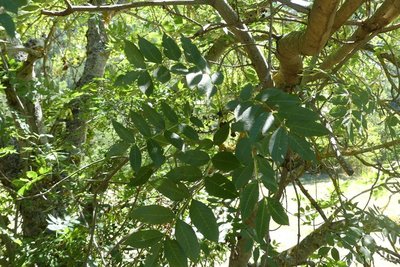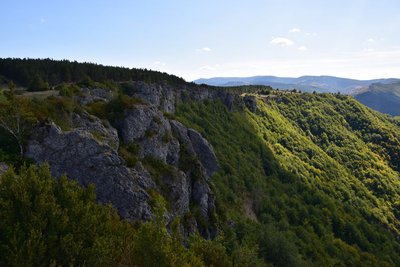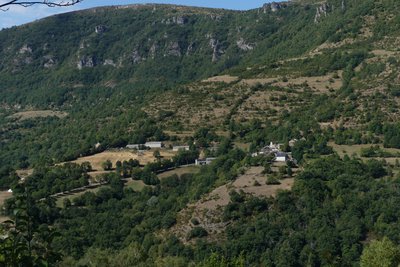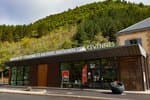
The corniches de l’Hospitalet
4 points of interest

Frêne commun - Nathalie Thomas  Flora
FloraAsh trees
Ash trees, like the ones that border the path, like cool and damp environments. They were planted alongside paths by locals because ash branches, cut towards the end of summer, provided additional fodder for livestock.

Ephippigère des Vignes - Nathalie Thomas  Fauna
FaunaBush crickets
Dry grassland is home to a multitude of insects, including bush crickets. At night, they produce a squealing sound by rubbing the stubs of their wings together. The sound has given them the name of “gouzi”. But despite their musical wings, they cannot fly, and hide in vegetation (such as boxwood or juniper bushes) to escape predators.

Relief de la Can de l’Hospitalet - Florac - Sud Lozère  Geology
GeologyThe evolution of the landscape
140 million years ago, the sea was shrinking, and the Can de l’Hospitalet and Causse Méjean were not yet separated by the Tarnon valley. The landscape was completely different then. In a hot and humid climate, limestone “turrets” overlooked rivers whose routes were different from today's. Successive uplifts, shifts on either side of geological faults and the slow work of erosion have created the relief you see today. You have panoramic views over the valley of the Baumale, a tributary of the Tarnon, and, opposite you, the Causse Méjean. It is difficult to make out the limit between the limestone zone and the schist zone in this heavily wooded landscape.

Village de Vernagues - Nathalie Thomas  Geology
GeologySchist or dolomite
Schist areas form a rock base on which layers of sediment - limestone and dolomite - have collected. These are covered in chestnut trees and heaths of heather, broom and ferns unless they have been reforested. Underneath this vegetation, the transition between the two bedrocks is not always visible, but it is indicated by the human settlements at mid-slope. Rainwater that has filtered through the rocks emerges again where it hits the impermeable schist, creating springs.
Description
Start from the roadside of the D 9. Take the path lined by ash trees that heads west. Once you are on the heights of the Can de l’Hospitalet, take the path on the right that goes down into the Tarnon valley. NB: The path may be difficult to see. Follow this small steep path to where it crosses the Broussous trail, and turn right towards L’Hospitalet. At the next crossing, continue straight. The path becomes rather steep for a few metres. At the next crossing, turn right to return towards L’Hospitalet.
- Departure : L’Hospitalet
- Arrival : L’Hospitalet
- Towns crossed : Vebron
Forecast
Altimetric profile
Recommandations
Make sure your equipment is appropriate for the day's weather conditions. Remember that the weather changes quickly in the mountains. Take enough water, wear good shoes and put on a hat. Please close all gates and barriers after yourself. This walk can be extended by adding the Broussous trail.
Information desks
Tourism'house and national Parc at Florac
Place de l'ancienne gare, N106, 48400 Florac-trois-rivières
This office is part of the National Park's associated tourist-information network, whose mission is to provide information on, and raise awareness of, the sites and events as well as the rules that must be observed in the National Park's central zone.
On site: exhibitions, video projections, events and shop Open year-round
Access and parking
From Florac, take the D 9 road, direction Saint Jean du Gard
Parking :
Calculateur d'itinéraire Lio
Utilisez le calculateur liO pour organiser votre trajet en région Occitanie.
Autres régions
Calculez votre itinéraire en Auvergne Rhône Alpes sur Oùra
Biodiversité autour de l'itinéraire
Source


Report a problem or an error
If you have found an error on this page or if you have noticed any problems during your hike, please report them to us here:

